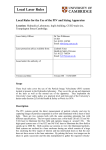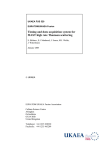Download Excalibur 659 Manual
Transcript
Laser Technology Excalibur Red Laser System Leisure Version User Guide Laser Technology Ltd, PO Box 488 Haverhill Suffolk CB9 7UA, UK. Tel. +44 (0) 1440 703627. . All rights reserved. No part of this guide may be reproduced, stored, or transmitted in any form by any means, without the prior permission of Laser Technology Ltd. 20/06/07 2 CONTENTS Page 2 Page 3 Page 4 Page 5 Page 6 Page 7 Page 8 Page 9 Safety and Warnings Product Description and Connections Turning On and Off Servicing Troubleshooting Do’s and Dont’s Connectors and Pin Connections Changing the KTP crystal SAFETY AND WARNINGS PLEASE READ THIS SECTION CAREFULLY BEFORE USING THE LASER. It is necessary to remove the cover from the control unit during installation. Any maintenance or service needing access to the interior of the laser system should be carried out by a qualified technician. Carrying out procedures other than those specified could result in user exposure to hazardous laser radiation and damage to the laser system The laser head and control unit of this product contain electrical circuits operating at HIGH VOLTAGES. THESE HIGH VOLTAGES ARE LETHAL Whenever you wish to gain access to the interior of the control unit, but it is not necessary to operate the laser, ISOLATE THE POWER SUPPLY AT THE MAIN CIRCUIT BREAKER. Only qualified and suitably experienced personnel should be permitted access to the interior of the control unit while the laser is operating and at all times must EXERCISE EXTREME CAUTION TO AVOID CONTACT WITH HIGH VOLTAGE POINTS. Technicians must not work on any electrically live system without another person present. Always remember NEVER look directly into the beam When examining the laser output, always set up a specific target for the beam Never operate the laser where the beam is at eye level Post warning signs near the laser area. Set up controlled-access areas strictly for laser operation. Limit access to such areas only to people who must be there and are instructed in the safe operation of the laser. The laser is a Class 4 product and must be treated accordingly. The laser conforms to the current EEC safety standard. Environmental requirements Operating temperature 15 to 35 degrees C Relative humidity 5 to 90% (non condensing) Altitude Sea level to 10,000 feet 3 PRODUCT DESCRIPTION The system comprises three units 1. 2. 3. Laser Head Control unit Remote control The Laser Head contains The NdYAG laser cavity, which produces the fundamental Infra Red (IR) lasing action The Second Harmonic Generator crystal, which converts the IR to visible output. The Q-switch, which converts the CW mode of operation to high peak power pulses, to improve the conversion efficiency from IR to visible Other optical components required to produce the scanned images. Pipework for cooling of the YAG rod, diodes and the Q-switch. Temperature controller for the SHG crystal mount. Control electronics and scanners for producing the scanned images The Control Unit supplies the diodes with an adjustable current, variable from 0 amps minimum, up to around 25 amps at low voltage. The unit also houses the RF driver, producing an oscillating signal for the optical Q-switch to gate the cavity on and off at a frequency of around 18KHz. The unit contains the logic which ensures all operational parameters are sequenced correctly, are continually monitored and are fully interlocked. It also houses the chiller, to maintain the cooling water, flowing through the diode assembly and Q switch, at a precise temperature of 20 degrees. Water flow rate, temperature and reservoir level are monitored and interlocked to the control unit for continuous, safe operation. The Remote Control allows the operator to: Start the system Operate the intra-cavity and external shutters Adjust the diode current Switch from CW to Q switch Adjust the Q switch repetition frequency Turn off the system CONNECTIONS The control unit requires a 220 volt 13 amp electrical supply. A three metre umbilical connects the laser head to the control unit. This umbilical contains all the cables and hoses required for the controller to drive the laser head. The sockets on the rear of the controller are clearly marked and cannot be incorrectly connected. As the controller houses the refrigerant chiller, it must be sited with ample space around it to allow for free flow of air. 4 WARNING. Before turning on, make sure you have filled the chiller reservoir with DISTILLED WATER, NOT DE-IONISED WATER. The reservoir requires 3 litres of clean distilled water, which may need topping up when the system has started. NOTE. It is important to check that the plastic bowl water filter, in the chiller, is clean and contains a filter element. Check the filter element for visible signs of clogging.This is normally apparent with darkening of the element.The element will need replacing, or at least a thorough cleaning, regularly. If the element becomes clogged up, the flow sensor in the chiller will not allow the system to operate. TURNING ON 1.Check water connections for leaks. 2.Turn on the mains switch on rear panel of controller. 3.Turn the key clockwise on the remote. It is important at this stage to allow the SHG crystal to heat up to the required temperature of 42.5 degrees. The heating process does not start until the remote key is turned. It then takes 30 minutes for the crystal mount to reach equilibrium temperature. Operation of the laser before this will result in reduced, or no, output. 4. Open the CAVITY and EXTERNAL SHUTTER from the remote. 5. Press MENU to select “I” (current) on remote display. 6. Press Q-SWITCH . 7. Turn control to desired power level. ALWAYS TURN UP SLOWLY. Turning up too fast may produce instability in the output. The Q switch repetition frequency can be adjusted, between safe limits, by pressing MENU to select REP on the display. Turning the control will then vary the rep rate. Pressing MENU again will put the control in a locked mode. Press MENU again to revert to current control. To Turn Off, just turn the key anti-clockwise. The system will automatically, de-energise the diodes and Q switch and close the shutters. The chiller will stay on for a brief, safe period and then shut down. Now switch off the mains supply. All key operational parameters are continuously monitored. On the front panel of the controller there are eight red lights. These indicate an OK status for: WATER FLOW WATER TEMPERATURE WATER LEVEL HEAD INTERLOCK EXTERNAL INTERLOCK Q SWITCH TEMPERATURE REFRIGERATION LOW REFRIGERATION HIGH A green light indicates POWER ON If the system shuts down during operation, one, or more, of the red lights will have gone out, showing the failure mode. 5 SERVICING WARNING. Do not attempt to adjust any of the pre-set controls within the laser head or control unit. This would invalidate all operational warranties on the system. If the following procedures do not restore full operational power, then you MUST contact Laser Technology. Periodic Servicing All optical components are in sturdy, locked-off mechanical mounts and should not normally need adjustment. The laser cavity is also sealed from the surroundings by glass tubes and O-ring seals. If you think the output power is dropping, check for anything obvious, like dirt, or marks, on the optical surfaces. This will show up as excessive scatter around the affected area. All checks must be done at minimum diode current and in CW mode, with the Q- switch off. Check that the glass protective tubes are seated in their O-ring seals. Also, view the SHG crystal through the window on top of the crystal mount. If there is excessive scatter at either end of the crystal, this will need rectifying. However, access to the KTP crystal should only be attempted in a clean environment. If dust or smoke is allowed to enter the crystal compartment, it may settle on the optical faces and later burn the crystal coating, causing permanent damage. REMEMBER, CRYSTAL DAMAGE IS EXCLUDED FROM THE WARRANTY. Similarly, only attempt to clean the intra-cavity optics in a clean environment. If you do not have access to a clean area, do not open the cavity seals. Contact Laser Technology for assistance. In extreme operational conditions, it is possible to damage the crystal. This could be caused by dirt on the crystal face, or by operation at low repetition frequency, when very high peak power is generated in the pulse, or by both. For these reasons, the SHG crystal is excluded from the warranty. If in any doubt about what to do, contact Laser Technology. Do not try excessive adjustments to the optical mounts, as you may lose lasing action completely. You may try a slight adjustment of the crystal mount rotation about its vertical axis and then the X and Y adjustment screws on the output mirror mount and rear mirror mount to see if the power improves, but only if you are familiar with and confident of laser adjustment. When cleaning optical surfaces, only use high quality lens tissues or, cotton bud sticks, and clean, high grade methanol. NEVER OPERATE THE LASER WITH THE CRYSTAL REMOVED. As both cavity mirrors are 100% reflective in the IR, no energy is coupled out of the cavity and the intra-cavity power could be high enough to damage the optics. With the crystal in the cavity, it produces enough loss to keep the intra-cavity power down below the damage threshold. NEVER OPERATE THE LASER WITH THE CAVITY SEALS OPEN. When exposed to intense laser radiation, the KTP crystal develops a static charge, attracting airborne dust like a magnet. So the importance of a clean environment around the crystal, free from dust and smoke, cannot be over emphasised. If the optics have been exposed to contamination, do not run the laser, as this may cause damage. Clean the affected surfaces in a clean area, or seek advice from Laser Technology. 6 TROUBLESHOOTING GUIDE Symptom Probable Cause Action No visible output, but diode glow visible Shutter not open Free up solenoid flag. “D” connector in. Check water flow. Contact L.I. YAG rod damaged Low output power Dirt on optics Mis-aligned mirror(s) Mis-aligned KTP crystal KTP crystal damaged Clean. Align output and rear mirrors for peak power. Adjust orientation around vertical axis. Replace and align. Unstable output Q-switch mis-aligned Adjust angle for max power and min instability. No Q-switching RF drive turned off Over heated Switch off and re-start Check water temp and flow. System has tripped out Water level low Water overheated Cover interlock open Ext interlock open Kinked piping Blocked water filter Top up. Check level Close or override. Close. Rectify. Change element If in any doubt about what to do, contact Laser Technology. DO NOT try to tackle any fault if you are unsure of the problem, or you are not confident in your technical ability to rectify it. 7 DO’S Always follow the correct start-up and shut down procedures Always turn the laser power down when high power is not required Post warning signs in the laser area Restrict access to experienced persons Always use common sense and extreme caution DON’TS Never route the umbilical where it can be stepped on or restricted Never operate the laser at eye level and never look directly into the beam Never allow inexperienced persons to operate the laser Never aim the beam at materials like curtains. The power is enough to start a fire In the event of any problems contact Laser Technology Ltd on +44(0)1440 703627 8 PIN CONNECTIONS Scanning Input 10 Way Connector Pin 1 Pin 2 Pin 3 Pin 4 Pin 5 Pin 6 Pin 7 Pin 8 X+ Xground Y+ Yblanking external shutter control shutter output Link pins7 and 8 for external shutter control from remote control. For external control of shutter, drive 5V+ into pin 7 with respect to pin 3. With no link between pins 3 and 6, the cavity is blanked. To remove blanking, Link pins 3 and 6. For external blanking, put 5V+ in pin 6. 0V on pin 6 will unblank the cavity. The external interlock plug is linked internally for closed circuit. This can be wired to an external switch e.g. a door switch. 9 INSTRUCTIONS FOR REPLACING THE KTP CRYSTAL In a clean environment 1.Remove the four M2.5 screws from the plastic crystal mount cover and remove cover. 2.Using tweezers, lift out the KTP. 3.Apply a small amount of thermal compound to bottom face of crystal slot. 4.Open new crystal box and orient crystal so that the arrow is on the top face. 5.Using tweezers, fit the crystal in the slot with the arrow on top and pointing to the output mirror. 6.Replace top cover and four retaining screws. 7.Turn on laser in Q-switch and increase current to 12 amps. If there is no lasing, increase until lasing occurs. Check that the beam is passing through the centre of the new crystal. You may need to adjust the two sets of push-pull screws to achieve this. 8.Adjust horizontal screws of crystal mount (to rotate crystal about a vertical axis) to optimise green output. 9. Project beam on to a screen at low power. You should see the main beam and a dimmer second spot. The second spot should be in line horizontally with the main spot. If it is not, adjust the two vertical screws which rotate the mount about a horizontal axis. This will bring the two spots horizontally in line. 10.Now adjust the vertical and then horizontal adjustment screws on the output mirror mount to optimise the power. 11. Now increase the diode current in steps of two or three amps, each time adjusting the two horizontal screws which rotate the crystal mount about its vertical axis, to optimise power. These will require very small adjustment, or possibly no adjustment at all. NB Whenever you have completed an adjustment, lock off the relevant set of screws to prevent drift.



















